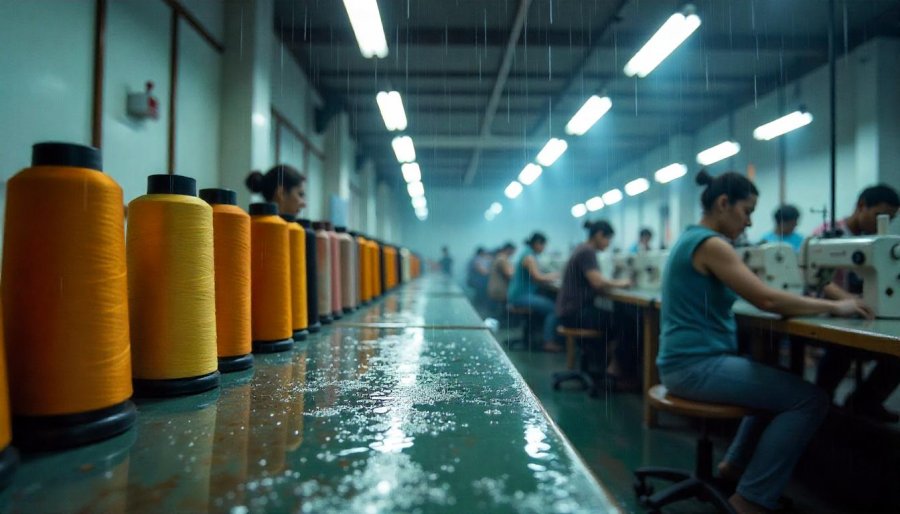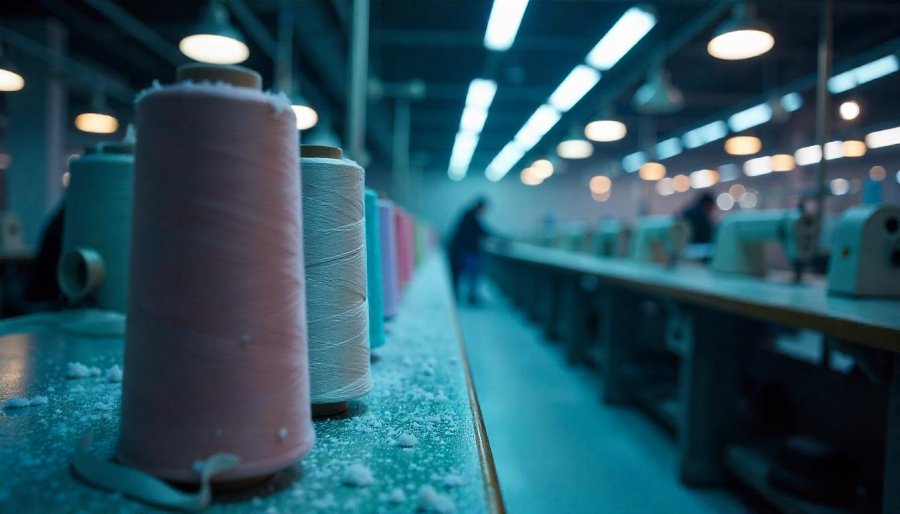Nylon, a fabric woven into nearly every aspect of our daily lives, is prized for its durability, flexibility, and affordability. Yet behind its convenience lies a troubling truth: its creation depends heavily on fossil fuels like oil and natural gas, fueling environmental degradation and climate change. From resource extraction to manufacturing, nylon’s lifecycle releases greenhouse gases and pollutants, while shedding microplastics that threaten marine ecosystems and human health. Its resistance to decomposition means it persists in landfills for decades, exacerbating plastic pollution. As awareness grows, innovative solutions—such as bio-based polymers and improved recycling—offer hope for a more sustainable future. But will industry and consumers embrace these alternatives fast enough to mitigate nylon’s ecological toll? Understanding the hidden costs behind this ubiquitous material urges us to rethink our choices, pushing for responsible production, smarter consumption, and a healthier planet.

Nylon’s Hidden Ubiquity: A Material We Use Every Day
Nylon is one of those materials that’s quietly everywhere in our daily lives. From the clothes we wear to the carpets under our feet, its presence is almost impossible to miss. Its popularity comes from a handful of key qualities: durability, flexibility, and affordability. These traits have made nylon a go-to choice for manufacturers and consumers alike since it was first developed in the 1930s. Over the decades, it has transformed countless industries—replacing natural fibers like silk and cotton in many applications—and become a staple in everything from fashion to household goods.
What makes nylon so appealing is its ability to do so much with so little cost. It’s easy to produce on a large scale, which keeps prices low and makes it accessible to most people. Its strength and elasticity mean it can withstand wear and tear, making it ideal for products designed to last. But behind this convenience lies a complex story rooted in chemical processes derived from fossil fuels. The raw materials used to make nylon—crude oil and natural gas—are refined into chemicals that form the basis of this synthetic fiber. This reliance on non-renewable resources is a critical point often overlooked when we enjoy the practicality of nylon.
Beneath its everyday presence, nylon’s origins reveal a reliance on energy-intensive manufacturing and finite resources. The process involves extracting crude oil and natural gas, then refining them into chemicals like hexamethylenediamine and adipic acid. These are bonded through polymerization, creating long, durable chains that become the fibers we see in textiles and industrial products. This process consumes significant energy and releases pollutants such as greenhouse gases and chemical runoff, which can contaminate local ecosystems. The widespread use of nylon is thus closely tied to ongoing resource extraction and consumption.
Beyond its manufacturing, nylon’s lifecycle impacts the environment in profound ways. During washing and wear, nylon fibers shed microplastics that easily enter waterways, where they are difficult to filter out. These tiny plastics pose a threat to marine life at all levels, from plankton to fish, disrupting ecosystems and entering our food chain. Because nylon is so durable, it resists decomposition in landfills, lingering for decades and adding to the global plastic pollution crisis. Recognizing these hidden costs is essential to understanding the true impact of a material we often take for granted.
Unveiling Nylon: Its Chemical Blueprint and Industrial Role
Nylon is a synthetic polymer created through a series of chemical reactions that hinge on petrochemicals. Its molecular structure consists of long chains of repeating units, which give the fiber its notable strength, elasticity, and resistance to wear and chemicals. These qualities have made nylon a preferred choice in a broad range of consumer products, from clothing and outdoor gear to carpets and industrial materials. Since its invention in the 1930s, nylon has transformed many industries by providing a durable, affordable alternative to natural fibers like silk and cotton.
The manufacturing process begins with the extraction of raw materials—primarily crude oil and natural gas. These fossil fuels are refined into chemicals such as hexamethylenediamine and adipic acid, which serve as the building blocks for nylon. Through a process called polymerization, these chemicals are heated under high pressure, causing them to bond into long, strong chains that form the basis of nylon fibers. This process is energy-intensive and releases pollutants, including greenhouse gases and chemical waste, which can contaminate local ecosystems.
Nylon’s chemical makeup and production reveal the extent of its environmental footprint. Its creation depends heavily on the continuous extraction and processing of finite natural resources, contributing to habitat destruction and pollution associated with oil drilling. The high energy demand of polymerization further accelerates greenhouse gas emissions, tying nylon’s lifecycle directly to the fossil fuel industry. Additionally, the chemicals involved often generate waste byproducts, which require careful management to prevent environmental contamination. Improper disposal or accidental release of these substances can have lasting ecological impacts.
Beyond manufacturing, nylon’s environmental impact extends into its use and disposal. During washing and wear, nylon fibers shed microplastics that easily enter waterways. These tiny particles are difficult to filter out and pose a threat to marine life at all levels, from plankton to fish, disrupting ecosystems and entering the food chain. Because nylon is so durable, it resists decomposition in landfills, where it can persist for decades, gradually breaking down into microplastics and contributing to the global plastic pollution crisis.
Understanding nylon’s chemical and environmental background underscores how deeply its production relies on non-renewable resources. While it offers undeniable benefits—such as affordability and durability—the hidden costs of environmental degradation and pollution highlight the need for alternative approaches. Innovations like bio-based polymers from renewable sources and improved recycling methods are emerging as promising solutions. These advancements aim to replicate nylon’s qualities while minimizing its ecological footprint, paving the way for a more sustainable future.

The Environmental Toll of Nylon Manufacturing and Use
Nylon production has a substantial environmental footprint, primarily driven by the release of pollutants during manufacturing. The chemical processes required to transform raw petrochemicals into fibers emit potent greenhouse gases like nitrous oxide, which is significantly more effective at trapping heat than carbon dioxide. These emissions contribute directly to climate change, intensifying the environmental challenges we face. Factories also release volatile organic compounds (VOCs) and hazardous chemicals into the air, which can form smog and pose health risks to nearby communities. When these pollutants settle into water sources, they threaten ecosystems and contaminate local water supplies.
The dependence on fossil fuels amplifies nylon’s environmental impact. Extracting and refining oil and natural gas disrupts habitats, causes spills, and introduces pollutants into soil and water. The energy-intensive process of manufacturing nylon relies heavily on burning fossil fuels, which accelerates greenhouse gas emissions. This creates a paradox: the very resources used to produce nylon are fueling the climate crisis. The chemicals involved in production often generate waste byproducts that, if not properly managed, seep into soil and waterways, contaminating ecosystems and harming wildlife.
Microplastic pollution stands out as a major concern linked to nylon manufacturing. Tiny fibers shed during washing, wearing, and manufacturing are easily released into waterways, where they are difficult to filter out. These microplastics enter marine ecosystems at all levels, from plankton to fish, disrupting food chains and endangering biodiversity. Because nylon fibers are durable, they persist in the environment for decades, accumulating in oceans and rivers and slowly breaking down into smaller particles. This pollution not only affects aquatic life but also eventually makes its way into human food sources.
Disposal of nylon products intensifies environmental problems. Its resistance to decomposition means that discarded items—clothing, packaging, and industrial waste—can linger in landfills for many years. Over time, these fibers break down into microplastics, leaching into soil and water, and continuously polluting ecosystems. The durability that makes nylon so popular as a material transforms it into a long-lasting burden, contributing to the global plastic pollution crisis and complicating waste management efforts.
Chemical waste generated during nylon manufacturing adds another layer of ecological harm. Waste byproducts, if mishandled, can contaminate soil, water, and air, affecting plant and animal life in surrounding areas. Despite regulations, illegal dumping and inadequate waste treatment remain issues in many regions, exacerbating environmental degradation. These persistent contaminants can have long-term effects on local ecosystems, often entering the food chain through contaminated water and soil.
The cumulative impact of nylon’s lifecycle—production, use, and disposal—illustrates its deep environmental toll. Its reliance on finite fossil fuel resources and energy-intensive manufacturing contribute to global warming and habitat destruction. Microplastics shed from nylon fibers infiltrate oceans and waterways, threatening marine life and human health. Because nylon resists decay, it accumulates in landfills, releasing harmful chemicals over decades. Reducing these impacts requires a shift toward sustainable alternatives and improved waste management practices to curb this ongoing ecological damage.
To further mitigate nylon’s environmental impact, consumers and manufacturers are encouraged to explore sustainable alternatives, such as recycled fibers or biodegradable materials. Supporting initiatives that promote responsible production and waste management can also make a significant difference. For more information on eco-friendly options, you can visit this comprehensive guide on sustainable nylon alternatives.
Innovating for a Greener Future: Sustainable Alternatives to Nylon
As awareness of nylon’s environmental footprint increases, the push for sustainable alternatives is gaining momentum. Researchers and companies are exploring bio-based polymers derived from renewable resources such as plant fibers, algae, and other natural materials. These innovations aim to match nylon’s durability and flexibility but with a significantly lower ecological impact. For instance, algae-derived biopolymers can be produced using less energy and emit fewer greenhouse gases, offering a promising pathway toward greener textiles. While these options are still in development, early results suggest they could eventually replace traditional nylon in many applications, helping to cut carbon emissions and reduce reliance on finite fossil fuels.
Recycling has become a crucial strategy in reducing nylon’s environmental toll. Mechanical recycling involves shredding used nylon products into fibers that can be spun into new textiles, though this often results in some loss of quality over multiple cycles. Chemical recycling, on the other hand, breaks nylon down into its basic chemical components, enabling manufacturers to produce fibers almost identical to virgin nylon. These processes help close the loop, transforming waste into valuable resources and minimizing the need for new raw materials. However, widespread adoption depends on improving collection systems, standardizing processing methods, and making recycling more economically viable for industries.
Policy frameworks and industry standards also play a vital role in fostering sustainability. Stricter emission regulations for manufacturing facilities can incentivize cleaner technologies and lower harmful pollutants. Providing tax credits and subsidies for using recycled or bio-based nylons encourages companies to adopt greener practices. Transparency through eco-labels and certifications helps guide consumers toward responsible choices, creating market pressure for sustainable products. These measures collectively can drive a shift in industry standards, making environmentally friendly options more accessible and appealing.
Product design offers additional opportunities to promote sustainability. Companies are developing nylon-based items with longer lifespans, modular components, and easier recyclability. Some brands are experimenting with biodegradable fibers that break down more quickly in natural environments, although balancing durability with eco-friendliness remains a challenge. Rethinking product life cycles—favoring repairability, reusability, and recyclability—can significantly reduce waste and microplastic shedding. Such innovations are essential to creating a circular textile economy that minimizes environmental impacts from start to finish.
Consumer awareness and behavior are key to accelerating this transition. When buyers understand the environmental costs tied to nylon, they are more likely to support products made from recycled or sustainable materials and to demand responsible manufacturing. Simple actions like washing clothes less frequently or using microfiber filters can drastically reduce microplastic pollution. As demand for eco-friendly options grows, industries will feel increasing pressure to innovate and adopt sustainable practices. Collective efforts from individuals, companies, and policymakers can help reshape the future of textiles—making durability and affordability compatible with environmental responsibility.

A Call to Action: Rethinking Nylon for a Sustainable Tomorrow
Nylon’s presence in our daily lives is undeniable, yet its environmental cost is often hidden behind its convenience and affordability. Its production relies heavily on fossil fuels, which are finite resources that contribute to pollution, climate change, and habitat destruction. Every stage—from extraction and manufacturing to use and disposal—adds pressure to our planet’s ecosystems and climate stability. Microplastics shed from nylon fibers enter waterways and oceans, harming marine life and making their way into our food chain. Meanwhile, landfills fill with durable nylon products that take decades to break down, continuously releasing microplastics and chemicals long after their initial use.
Understanding this full lifecycle reveals a pressing need for change. Consumers hold significant power to drive it—by choosing recycled or sustainable materials, supporting responsible brands, and reducing unnecessary consumption. Small actions like washing clothes less often or using microfiber filters can make a meaningful difference in limiting microplastic pollution. Industry leaders also have a crucial role: investing in innovative bio-based fibers and improving recycling practices can substantially lower nylon’s environmental footprint. Policy measures, such as stricter emission standards and incentives for sustainable materials, can accelerate this shift and create a more level playing field for greener alternatives.
The good news is that alternatives are emerging. Bio-polymers derived from renewable sources like algae and plant fibers are being developed to match nylon’s durability while reducing reliance on fossil fuels. Recycling technologies—both mechanical and chemical—are advancing, enabling used nylon to be reprocessed into new fibers with less waste and resource consumption. These innovations are promising steps toward a circular economy for textiles, where waste is minimized, and products are designed to last longer and be more easily recycled.
However, widespread adoption depends on collective effort. Consumers need to demand transparency and sustainability, industry must prioritize eco-friendly innovations, and policymakers should implement supportive regulations. Raising awareness about the environmental impacts of nylon and microplastics empowers everyone to make smarter choices. Supporting brands committed to sustainability and advocating for better waste management practices can accelerate progress.
Transitioning away from traditional nylon isn’t about instant change but about rethinking how we produce, use, and dispose of materials. It’s a shift toward responsibility—balancing our needs with the health of the planet. Every purchase, every advocacy, and every small act adds to a larger movement that can reshape the future of textiles. By recognizing the full story behind nylon, we take an important step toward sustainability and ecological resilience.
This change is a moral imperative, not just an environmental one. Our consumption patterns impact ecosystems, climate stability, and human health. Moving toward more sustainable options allows us to meet our needs without compromising the planet’s health. It’s about fostering innovation, enforcing accountability, and making informed choices that prioritize longevity over fleeting convenience. The future depends on our willingness to rethink and act.
Every effort counts—whether it’s supporting policies that promote recycling and bio-based fibers, choosing eco-friendly products, or simply spreading awareness. By staying informed and engaged, we can help shift the industry and consumer habits toward sustainability. Small decisions, when multiplied across millions of people, have the power to create significant change. It’s about building a future where convenience and responsibility go hand in hand.
The journey toward reducing nylon’s environmental impact is ongoing. It requires commitment from all sides—individuals, companies, and governments. Together, we can forge a path that respects both human ingenuity and ecological limits. The choices we make today will shape the world our children inherit. Embracing sustainable practices isn’t optional; it’s essential for safeguarding the future of our planet and ensuring resilience for generations to come.






